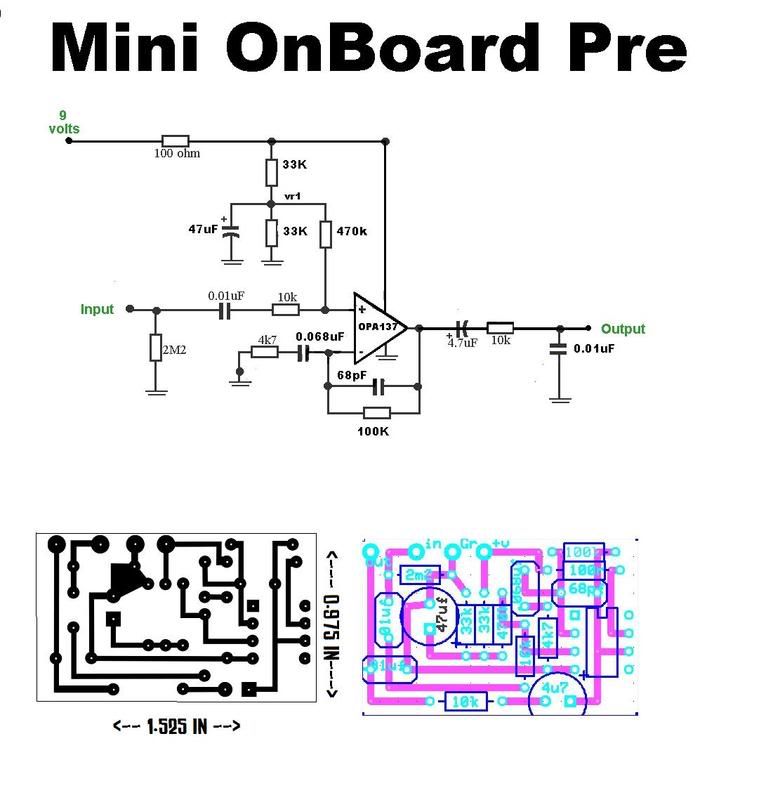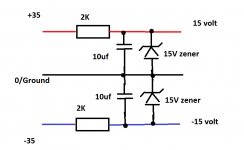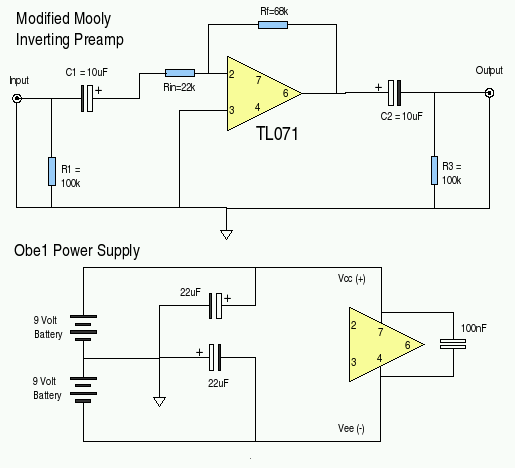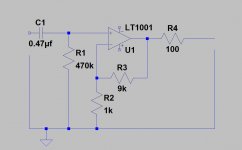Hey again guys. OK I purchased this amp kit Chip Amplifier Sales, LM3886 Audio Chip Amplifiers Representatives, Sound System Supplies
It has a very clear great sound. The only problem being that with a 35-0-35 vdc supply and a 8ohm speaker the electric guitar is louder without it. I keep reading about how great these chips are and how loud they can be. I just DO NOT SEE IT! I wrote the manufacturer of the kit I purchased and they simply wrote back "preamp needed". I see all of these posts and nobody mentions a NEED to preamp to get an audible sound out of a 8ohm speaker. What am I missing?
Any cheap easy preamp circuits?
My supply power is from a 25-0-25VAC 4A transformer running through a rectifier and buffer circuit. My final output voltage measures about 35-0-35 it has been a few days and cant remember exact number. I do remember it was not the 25X1.41 I was expecting. This is my first project and it is confusing me to death trying to figure this out.
http://www.gssound.com.gr/lm3886_foto_compronet.htm
It has a very clear great sound. The only problem being that with a 35-0-35 vdc supply and a 8ohm speaker the electric guitar is louder without it. I keep reading about how great these chips are and how loud they can be. I just DO NOT SEE IT! I wrote the manufacturer of the kit I purchased and they simply wrote back "preamp needed". I see all of these posts and nobody mentions a NEED to preamp to get an audible sound out of a 8ohm speaker. What am I missing?
Any cheap easy preamp circuits?
My supply power is from a 25-0-25VAC 4A transformer running through a rectifier and buffer circuit. My final output voltage measures about 35-0-35 it has been a few days and cant remember exact number. I do remember it was not the 25X1.41 I was expecting. This is my first project and it is confusing me to death trying to figure this out.
http://www.gssound.com.gr/lm3886_foto_compronet.htm
The input of a LM3886 amp expects a line level audio signal of about 0.7v-1v , a passive electric guitar puts out a low level instrument signal of maybe 200mv .....
so yes for a guitar you would need a high impedance preamp to get the instrument level signal up to line level ...... You will also need a preamp for shaping the tone as a guitar without a proper guitar preamp doesn't sound very good .....
Cheers
so yes for a guitar you would need a high impedance preamp to get the instrument level signal up to line level ...... You will also need a preamp for shaping the tone as a guitar without a proper guitar preamp doesn't sound very good .....
Cheers
One of the problems you have "preamplifying" a chip-amp is the rail voltages are higher than those which most opamps can sustain. You've got to be a little creative.
You can use an operational amplifier like the OPA2604 in "suspended supply" configuration -- and drive it off the power rails of the LM3886. See Linear Technology Magazine, pages 20-23: http://cds.linear.com/docs/LT Journal/LTMag_V04N2_Jun94.pdf
You can use an operational amplifier like the OPA2604 in "suspended supply" configuration -- and drive it off the power rails of the LM3886. See Linear Technology Magazine, pages 20-23: http://cds.linear.com/docs/LT Journal/LTMag_V04N2_Jun94.pdf
Remember that the supply voltage of the power amp (or any amp) has no relation to the gain which stays the same as the supply is altered.
The preamp can dead simple. Post #35 here should get you started,
http://www.diyaudio.com/forums/analog-line-level/210877-need-help-ne5543n-opamp-2.html#post2989964
The preamp can dead simple. Post #35 here should get you started,
http://www.diyaudio.com/forums/analog-line-level/210877-need-help-ne5543n-opamp-2.html#post2989964
One of the problems you have "preamplifying" a chip-amp is the rail voltages are higher than those which most opamps can sustain. You've got to be a little creative.
You can use an operational amplifier like the OPA2604 in "suspended supply" configuration -- and drive it off the power rails of the LM3886. See Linear Technology Magazine, pages 20-23: http://cds.linear.com/docs/LT Journal/LTMag_V04N2_Jun94.pdf
I generally overcome this by running the preamp in a single supply configuration then just use the +V from the power amp for the preamp , it negates having to regulate the PSU for the preamp and many opamps will run on 36v DC ......
Cheers
Do you mean post #71emitter amp help?
Yes, it was just for general examples of how simple an opamp based gain stage can be.
If your not sure then just ask 🙂
I'm sure there are plenty of kits available or you could just knock one up on veroboard very quickly and cheaply. The power supply is no problem, just two zeners and two resistors to run it off the LM3886 supply.
I'm sure there are plenty of kits available or you could just knock one up on veroboard very quickly and cheaply. The power supply is no problem, just two zeners and two resistors to run it off the LM3886 supply.
Build the preamp in this one:
100W Guitar Amplifier (Mk II)
or drive the power amp from a multi-effects processor such as a Zoom/Pod/V-Amp/Boss/etc.
Or a "distortion/preamp in a box" such as a Marshall Guvnor/Shredmaster/Jackhammer if you are mainly interested in Heavy sounds.
100W Guitar Amplifier (Mk II)
or drive the power amp from a multi-effects processor such as a Zoom/Pod/V-Amp/Boss/etc.
Or a "distortion/preamp in a box" such as a Marshall Guvnor/Shredmaster/Jackhammer if you are mainly interested in Heavy sounds.
Everyone keeps saying that Mooly but I have no idea how to figure that out. I know I will need to burn off some power but no clue as to the values of the components.
Everyone keeps saying that Mooly but I have no idea how to figure that out. I know I will need to burn off some power but no clue as to the values of the components.
No problem, lets start at the beginning. I'm assuming that as this is a guitar amp its just ONE channel rather than stereo, not that that makes any real difference to the basic design.
You have the LM3886 running on around -/+ 35 volts DC and an opamp based supply needs around -/+15 volts. The current needed depends to some extent on the opamp but lets go "worst case" meaning you can use virtually any. So you have 35 volts per rail, and you need 15 volts across the zener. The opamp could take up to say 8 milliamps depending what device was used. We also need to allow for a minimum zener current of say 2 milliamps.
And that's all the info we need 🙂
35 volts rail minus 15 volt zener value gives 20 volts to be "lost" per rail. We use a resistor. Value calculated as 20 volts / (8ma +2ma) which gives 2K
In practice we could also use 1K8 or 2K2. Wattage needed. Thats V squared/R which is (20*20)/1K8 giving 0.22 watt. We would use at least a 0.5 watt here. Using 1K8 as the value is also a "worst case" calculation. The 2K2 would be even lower.
Attachments
Your welcome 🙂
Now all those links were to give you an idea of opamp based preamps. The one in the picture above may not be ideally suited for a couple of reasons, most importantly, having a low input impedance. So here is a simple design.
1. The opamp MUST be a fet type such as TL071 or OPA134 etc. Dozens to choose from. The fet opamp allows for high input impedance and guarantees no DC offset issues.
2. R1 sets the input impedance. I've shown 470k but you can go higher (much higher) if needed. I believe guitar pickups are piezo devices and so need the highish impedance.
3. C1 both AC couples the input and forms a high pass filter in conjunction with R1. The values shown roll off around 0.7Hz.
3. The gain is set by the ratio of R2 and R3 and is (R3/R2)+1 so here we have a voltage gain of 10. You can set the gain to any reasonable level just by altering R3.
4. R4 is just for stability in case of any stray capacitance upsetting the opamp and causing oscillation at very high frequency.
I've left the opamp output as "DC coupled" (no output cap) because the FET opamp will have no appreciable DC offset.
The feedback is also DC coupled. Providing you retain C1 then this is acceptable for this application.
Now all those links were to give you an idea of opamp based preamps. The one in the picture above may not be ideally suited for a couple of reasons, most importantly, having a low input impedance. So here is a simple design.
1. The opamp MUST be a fet type such as TL071 or OPA134 etc. Dozens to choose from. The fet opamp allows for high input impedance and guarantees no DC offset issues.
2. R1 sets the input impedance. I've shown 470k but you can go higher (much higher) if needed. I believe guitar pickups are piezo devices and so need the highish impedance.
3. C1 both AC couples the input and forms a high pass filter in conjunction with R1. The values shown roll off around 0.7Hz.
3. The gain is set by the ratio of R2 and R3 and is (R3/R2)+1 so here we have a voltage gain of 10. You can set the gain to any reasonable level just by altering R3.
4. R4 is just for stability in case of any stray capacitance upsetting the opamp and causing oscillation at very high frequency.
I've left the opamp output as "DC coupled" (no output cap) because the FET opamp will have no appreciable DC offset.
The feedback is also DC coupled. Providing you retain C1 then this is acceptable for this application.
Attachments
So the input would go into C1 an the output off R4? Thanks for explaining the values and what they do to the outcome. Should be easy to get things perfect now.
here is a simple preamp I did a while back .....

I built it as a preamp that I built into my guitar ..... You can replace the 100k resistor in the feedback loop with a 100k pot for adjustable gain and it runs off of a single DC supply from 9v - 36v so there is no need for a regulated dual 15v supply ......
While the circuit looks simple it actually sounds pretty good and have installed a version of this circuit in guitars for several friends of mine and they all love it .....
Cheers

I built it as a preamp that I built into my guitar ..... You can replace the 100k resistor in the feedback loop with a 100k pot for adjustable gain and it runs off of a single DC supply from 9v - 36v so there is no need for a regulated dual 15v supply ......
While the circuit looks simple it actually sounds pretty good and have installed a version of this circuit in guitars for several friends of mine and they all love it .....
Cheers
- Status
- Not open for further replies.
- Home
- Amplifiers
- Chip Amps
- lm3886 help


